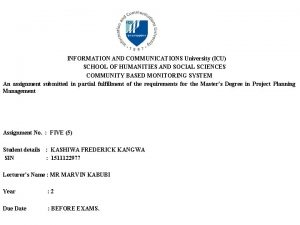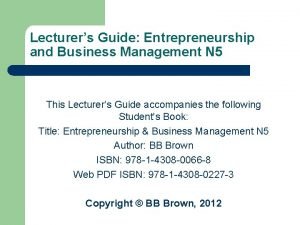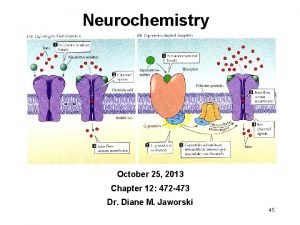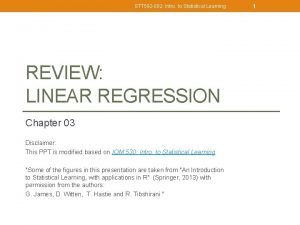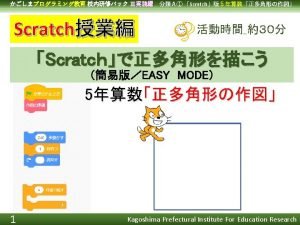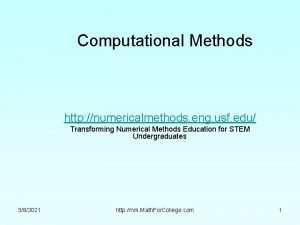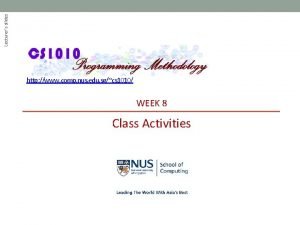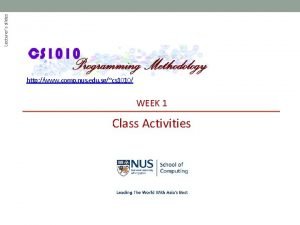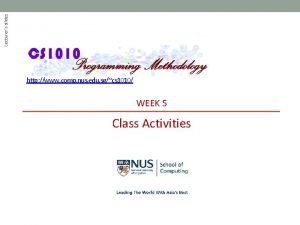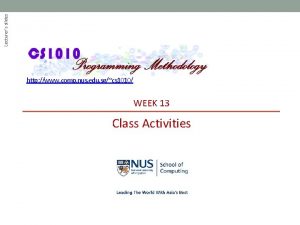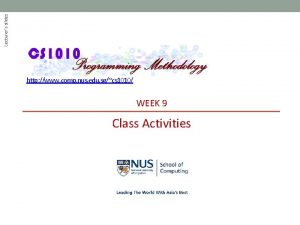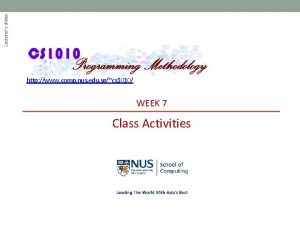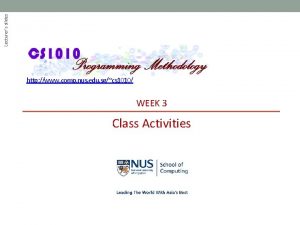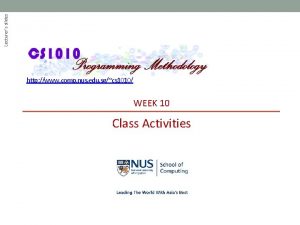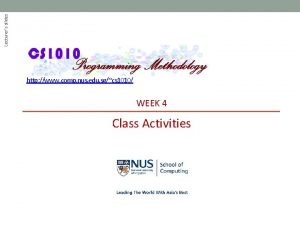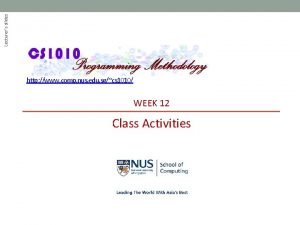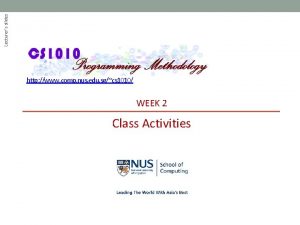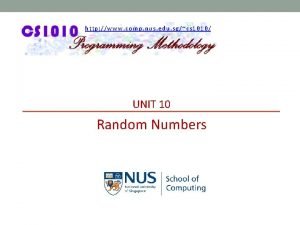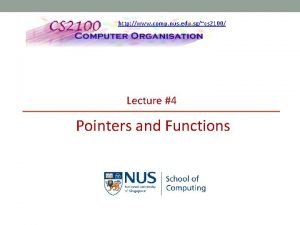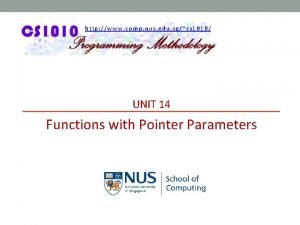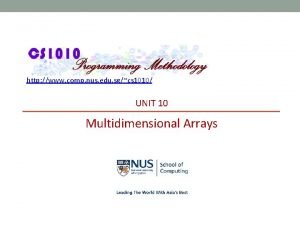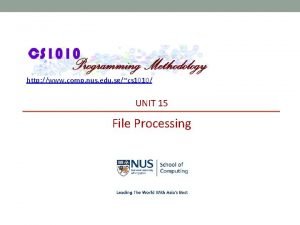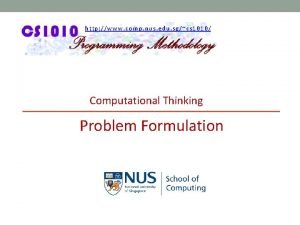Lecturers slides http www comp nus edu sgcs


















- Slides: 18

Lecturer’s slides http: //www. comp. nus. edu. sg/~cs 1010/ WEEK 6 Class Activities

© NUS CS 1010 (AY 2014/5 Semester 1) Week 6: Arrays Preparation § Unit #11: Random Numbers § Unit #12: Using UNIX I/O Redirection One-dimensional Arrays § Going through examples in Unit #10 Multi-dimensional Arrays § Exercise #1: Sum to Random Position § Exercise #2: Matrix Multiplication § Exercise #3: Valid Path Week 6 - 2

© NUS CS 1010 (AY 2014/5 Semester 1) Week 6 - 3 Random Numbers § We will go through Unit #11 Random Numbers.

© NUS CS 1010 (AY 2014/5 Semester 1) Using UNIX I/O Redirection § We will go through Unit #12 UNIX I/O Redirection Week 6 - 4

© NUS CS 1010 (AY 2014/5 Semester 1) Week 6 - 5 One-dimensional Arrays § We will go through the examples in Unit #10.

© NUS CS 1010 (AY 2014/5 Semester 1) Week 6 - 6 Multi-dimensional Arrays § We will go through the examples in Unit #10. § Work out the following exercises.

© NUS CS 1010 (AY 2014/5 Semester 1) Week 6 - 7 Exercise #1: Sum to Random Position (1/4) § Write a program Week 6_Sum. To. Random. Pos. c that reads in values (of type float) for a 2 D array with at most 5 rows and 8 columns, generates a random position in the array and sums the elements from index [0][0] to that position, in row-major order. § Your program should contain the function sum. Partial() to take in the array and a random position and return the sum of the elements up to that position. § § What are the parameters of sum. Partial()? The incomplete program Week 6_Sum. To. Random. Pos. c is given. Study the function scan. Array() closely.

© NUS CS 1010 (AY 2014/5 Semester 1) Week 6 - 8 Exercise #1: Sum to Random Position (2/4) § The sum is printed in 2 decimal places. § To ease data input, create a file to store the input data, and use UNIX input redirection to redirect input from this file when you execute the program. § Sample run: $ Enter rows and columns: 3 4 $ Enter 12 values: 5. 1 4. 2 -6. 3 12. 4 7. 5 8. 6 -3. 7 11. 8 9. 9 -20. 0 17. 1 10. 2 Sum to position [1][2] = 27. 80

© NUS CS 1010 (AY 2014/5 Semester 1) Week 6 - 9 Exercise #1: Sum to Random Position (3/4) #include <stdio. h> #include <stdlib. h> #include <time. h> #define MAX_ROWS 5 #define MAX_COLS 5 Week 6_Sum. To. Random. Pos. c void scan. Array(float [][MAX_COLS], int); int main(void) { float array[MAX_ROWS][MAX_COLS]; int rows, cols, up. To. Row, up. To. Col; printf("Enter rows and columns: "); scanf("%d %d", &rows, &cols); scan. Array(array, rows, cols); srand(time(NULL)); up. To. Row = rand() % rows; up. To. Col = rand() & cols; // call sum. Partial() function below printf("Sum to position [%d] = %. 2 fn"); // incomplete return 0; }

© NUS CS 1010 (AY 2014/5 Semester 1) Week 6 - 10 Exercise #1: Sum to Random Position (4/4) Week 6_Sum. To. Random. Pos. c void scan. Array(float arr[][MAX_COLS], int rows, int cols) { int r, c; printf("Enter %d values: n", rows * cols); for (r=0; r < rows; r++) for (c=0; c < cols; c++) scanf("%f", &arr[r][c]); } // Sum elements from position [0][0] to a random // position [up. To. Row][up. To. Col]. // Fill in sum. Partial() function below.

© NUS CS 1010 (AY 2014/5 Semester 1) Week 6 - 11 Exercise #2: Matrix Multiplication (1/3) § To multiply two matrices A and B, the number of columns in A must be the same as the number of rows in B. § The resulting matrix has same number of rows as A and number of columns as B § For example, multiplying a 2 4 matrix with a 4 3 matrix gives a 2 3 matrix. m n matrix n p matrix = m p matrix

© NUS CS 1010 (AY 2014/5 Semester 1) Week 6 - 12 Exercise #2: Matrix Multiplication (2/3) § To compute C = A B, where A, B, C are matrices ci, j = (ai, 1 b 1, j ) + (ai, 2 b 2, j ) +. . . + (ai, n bn, j ) ci, j is sum of terms produced by multiplying the elements of A’s row i with B’s column j. § Examples: § Complete the prod. Matrix() function in Unit 10_Matrix. Ops. c

© NUS CS 1010 (AY 2014/5 Semester 1) Week 6 - 13 Exercise #2: Matrix Multiplication (3/3) § Multiplying a 2 4 matrix with a 4 3 matrix: col 0 col 1 row 0 2 1 3 2 row 1 3 0 2 1 3 2 1 2 2 3 1 3 0 2 1 3 6 + 2 + 3 + 4 = 15 4 + 2 + 9 + 2 = 17 9 + 0 + 2 = 13 row 0, col 0 col 1 = ? 17 ? 11 ? 15 ? 13 row 1, col 0 ? 6

© NUS CS 1010 (AY 2014/5 Semester 1) Week 6 - 14 Maze (1/2) § Let’s consider a maze that is represented by a twodimensional 6 6 integer array. § The value of each array element is either 0 (representing a wall) or 1 (representing a cell). § The starting and exit points in the maze are specified by the cells maze[0][0] and maze[5][5] respectively. § A path is represented by a single-dimensional character array with four possible element values representing the move directions: ‘N’ (for north), ‘S’ (for south), ‘E’ (for east), and ‘W’ (for west). Each path is defined with respect to the starting cell maze[0][0].

© NUS CS 1010 (AY 2014/5 Semester 1) Week 6 - 15 Maze (2/2) § Example of a 6 6 maze Start 0 1 2 3 4 5 Exit Cell Wall

© NUS CS 1010 (AY 2014/5 Semester 1) Week 6 - 16 Exercise #3: Valid Path § § A path in a maze is defined to be valid if the path is within the maze and does not knock against any wall. 0 1 2 3 4 5 Examples: 0 § § § Valid path: ‘E’, ‘S’, ‘N’, ‘E’, ‘S’ Invalid path: ‘S’, ‘W’ Invalid path: ‘S’, ‘E’ 1 2 3 4 § Write a function 5 inis. Valid (int maze[][6], char path[]) that takes in a 6 6 maze and a path with at most 10 characters. It returns 1 if path is valid in maze, or returns 0 otherwise. § An incomplete program Week 6_Is. Valid. c is given. It handles string input which is not covered yet.

© NUS CS 1010 (AY 2014/5 Semester 1) Things-To-Do n Revise n n PE 1 n n n Chapter 6: Numeric Arrays This Saturday! Refer to CS 1010 website “PE” page for details Continue to do practice exercises on Code. Crunch Week 6 - 17

© NUS CS 1010 (AY 2014/5 Semester 1) End of File Week 6 - 18
 Information and communications university
Information and communications university Key performance indicators for lecturers
Key performance indicators for lecturers Ebm n5
Ebm n5 Lecturers without borders
Lecturers without borders Nus myedu
Nus myedu Dig comp edu
Dig comp edu A small child slides down the four frictionless slides
A small child slides down the four frictionless slides Energy of four forces quick check
Energy of four forces quick check Edu.sharif.edu
Edu.sharif.edu Epinephrine in the brain
Epinephrine in the brain Faculty marshall usc advertising csv
Faculty marshall usc advertising csv Https.//scratch.mit.edu
Https.//scratch.mit.edu Http://weather.uwyo.edu/upperair/sounding.html
Http://weather.uwyo.edu/upperair/sounding.html Http://dendro.cnre.vt.edu/forestbiology/photosynthesis.swf
Http://dendro.cnre.vt.edu/forestbiology/photosynthesis.swf Learn genetics utah
Learn genetics utah Http //2learner.hcmup.edu.vn
Http //2learner.hcmup.edu.vn Http://scratch.mit.edu/
Http://scratch.mit.edu/ Http://www.colorado.edu/physics/phet
Http://www.colorado.edu/physics/phet Numericalmethods.eng.usf.edu
Numericalmethods.eng.usf.edu
